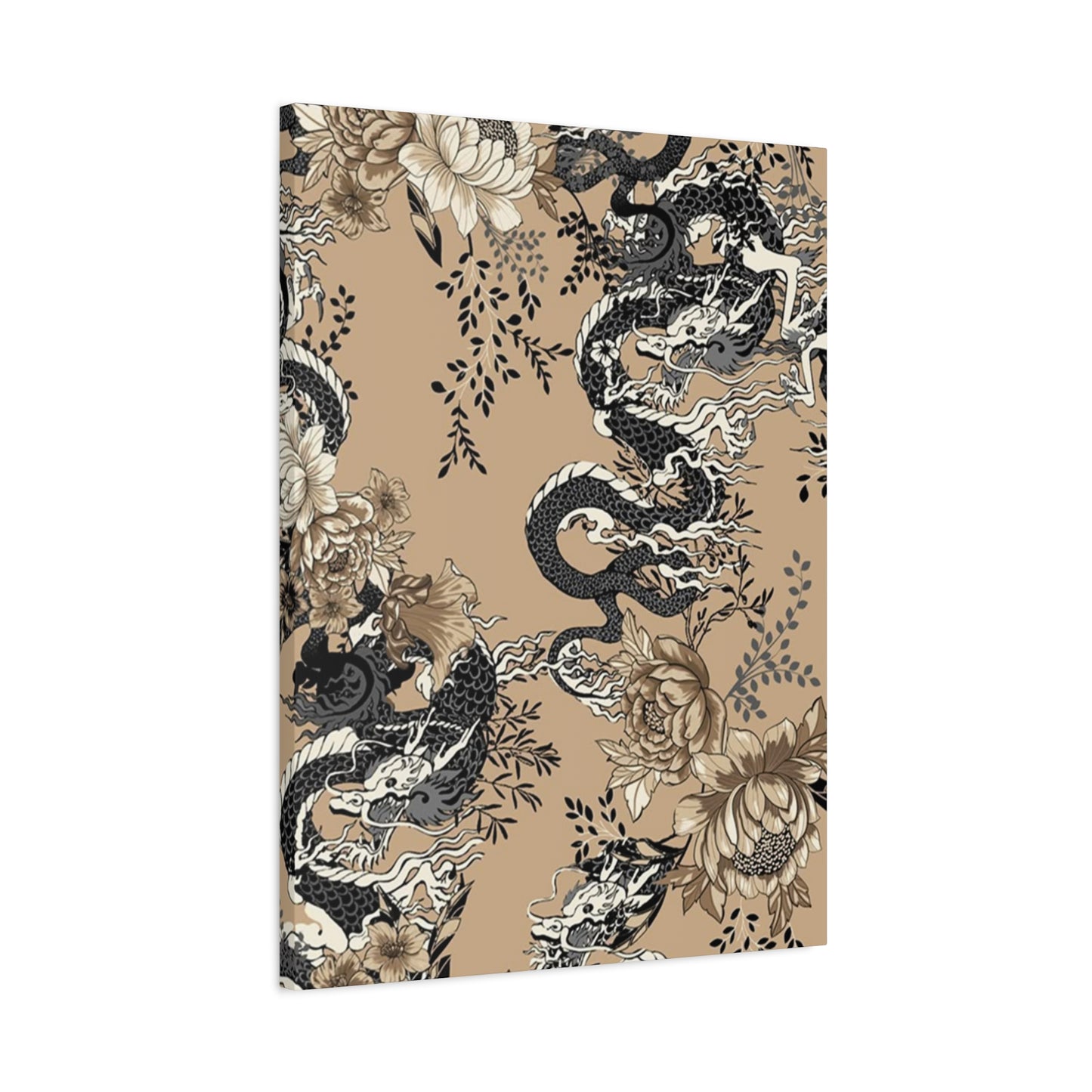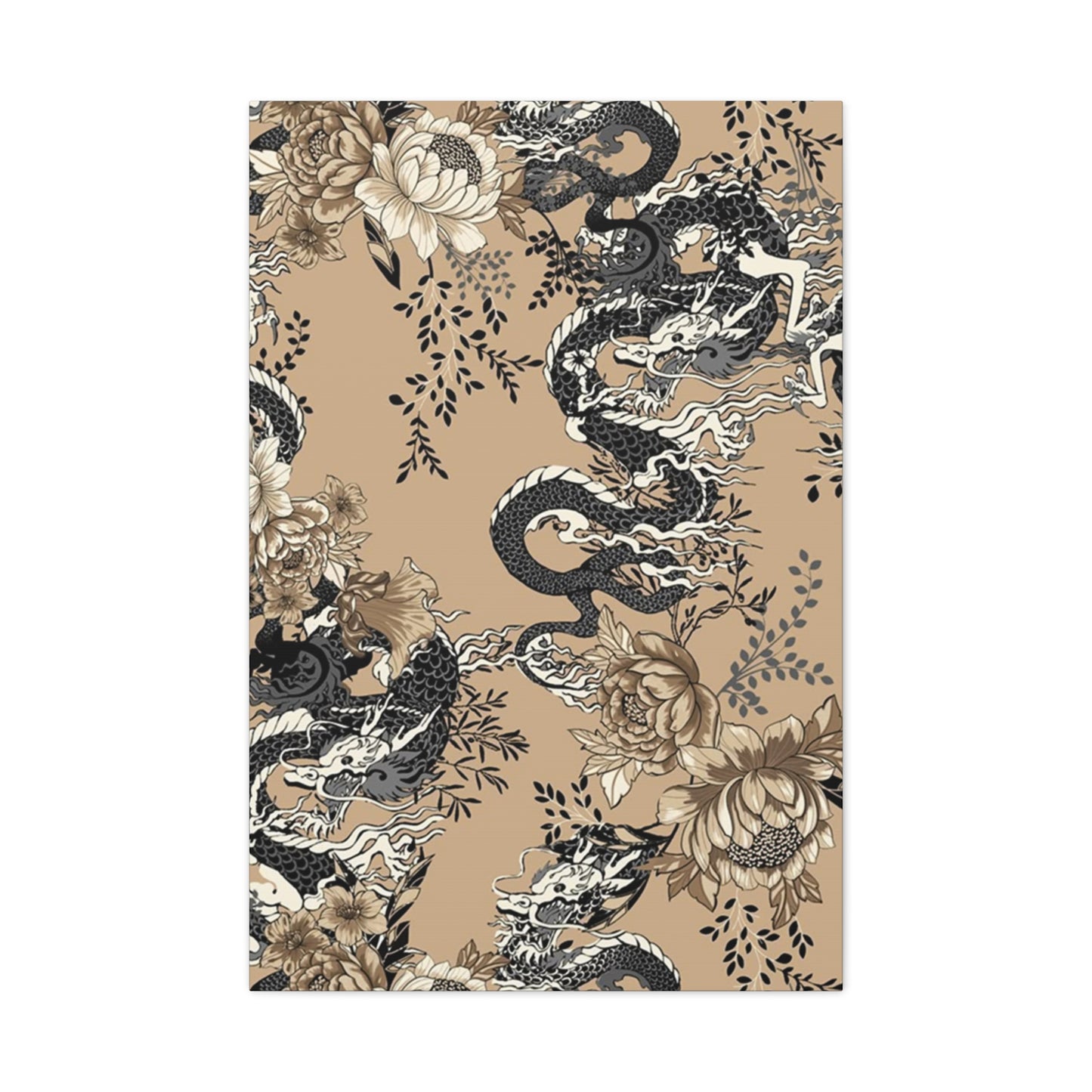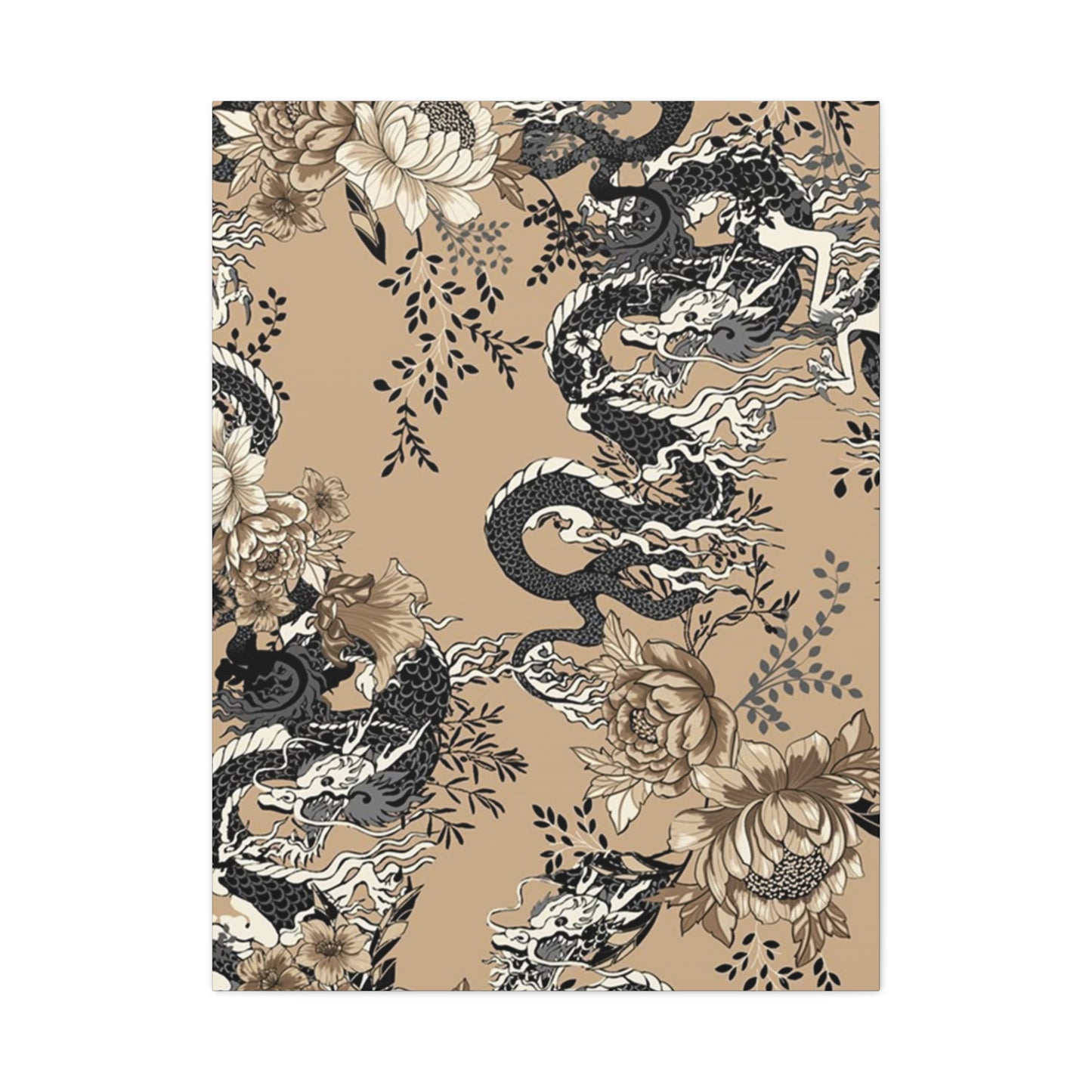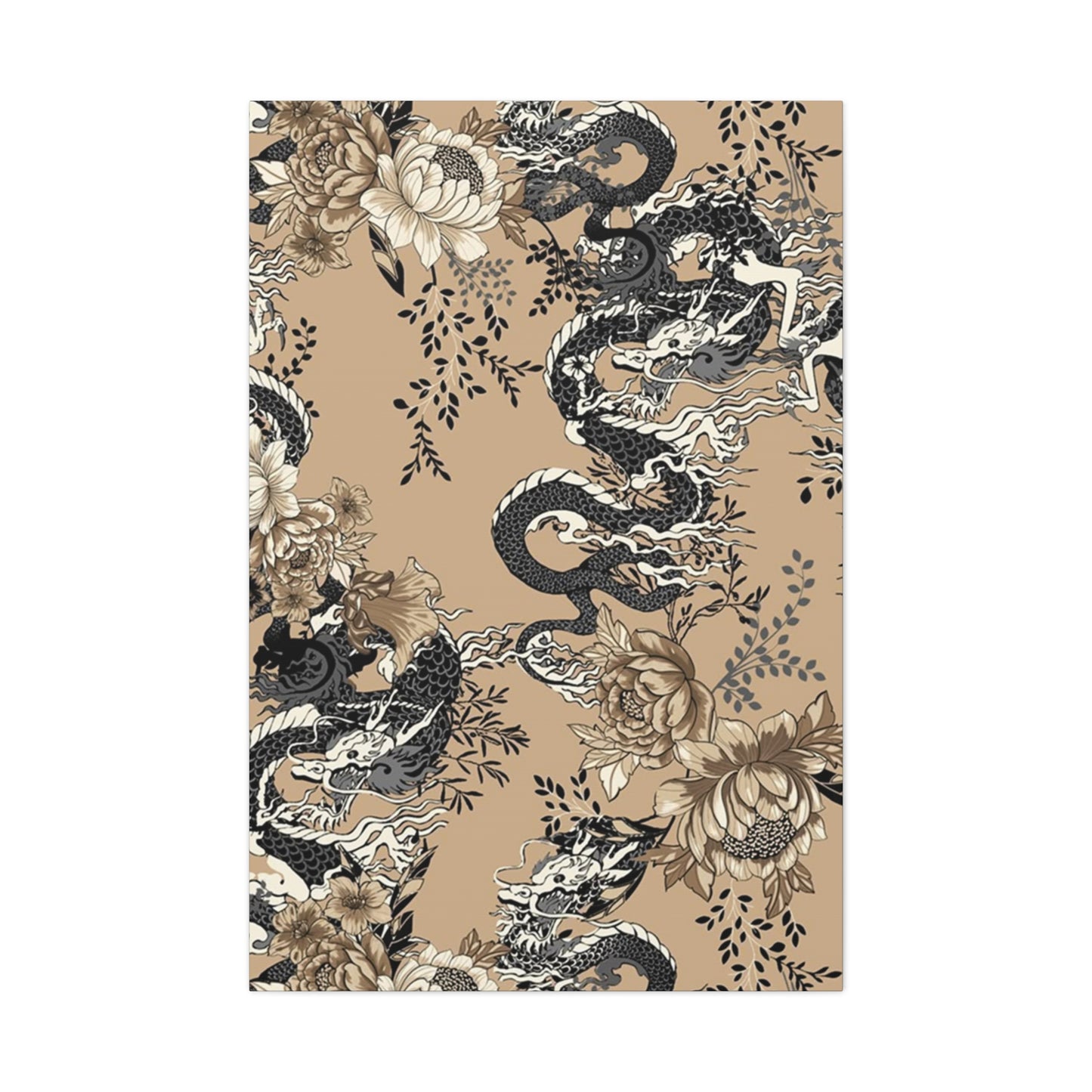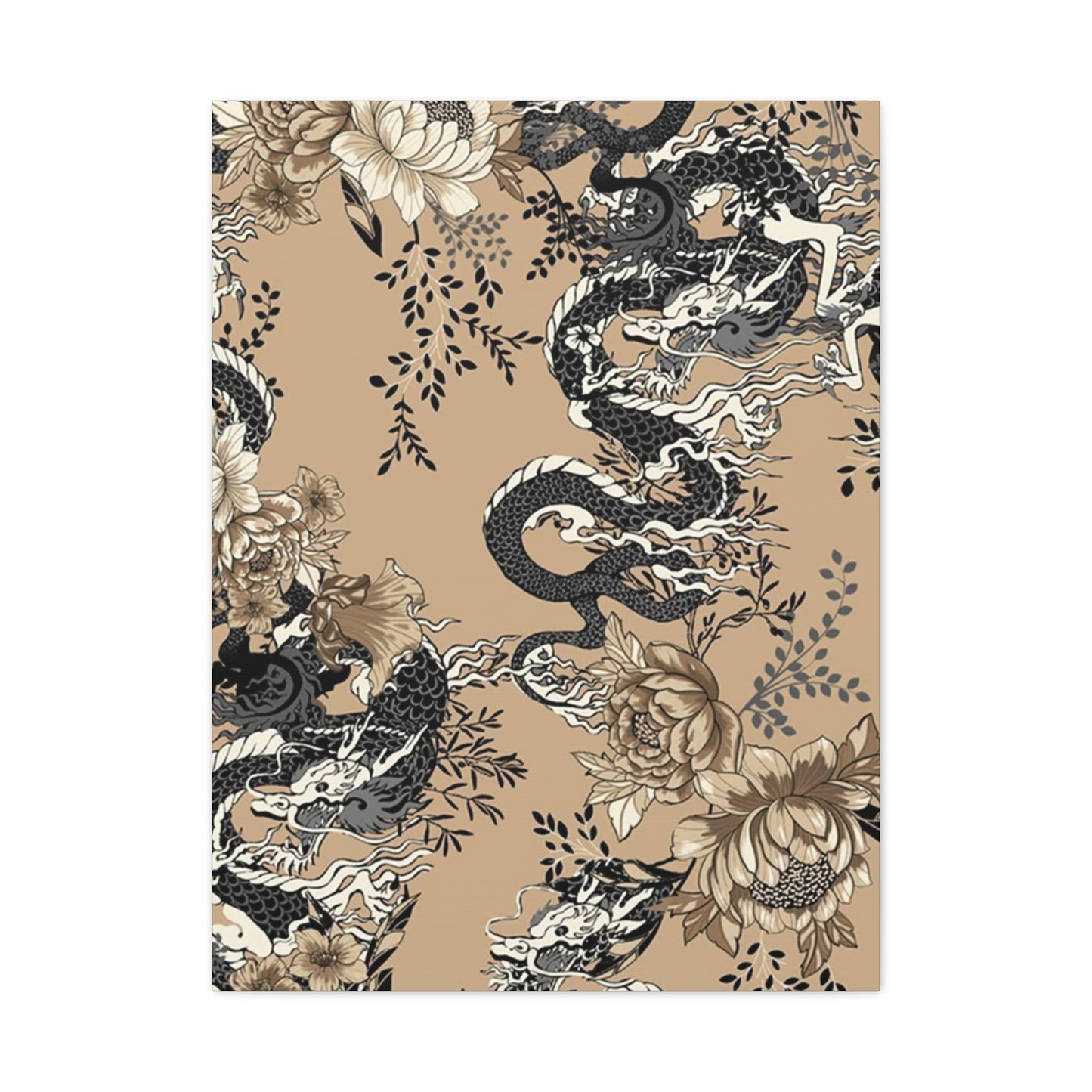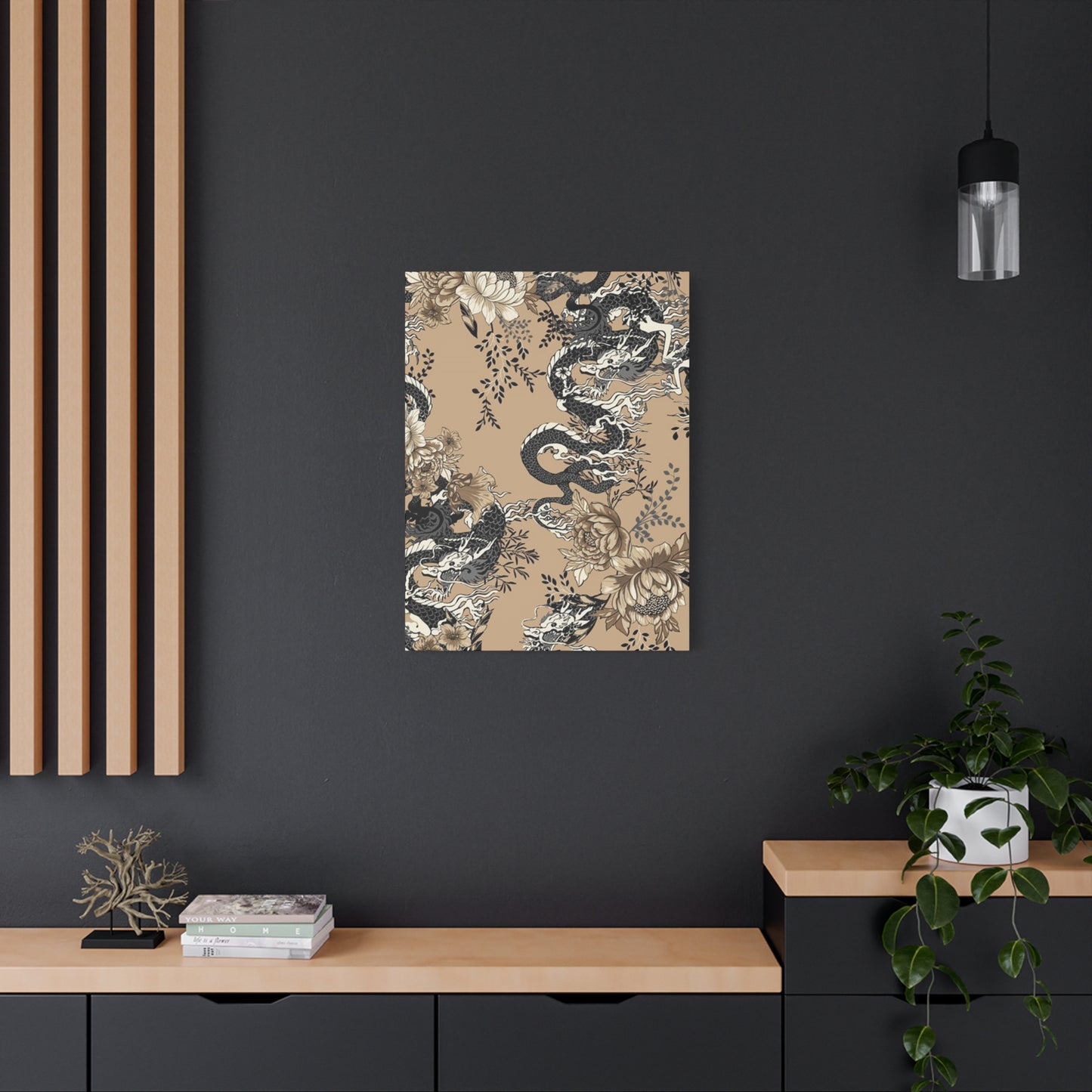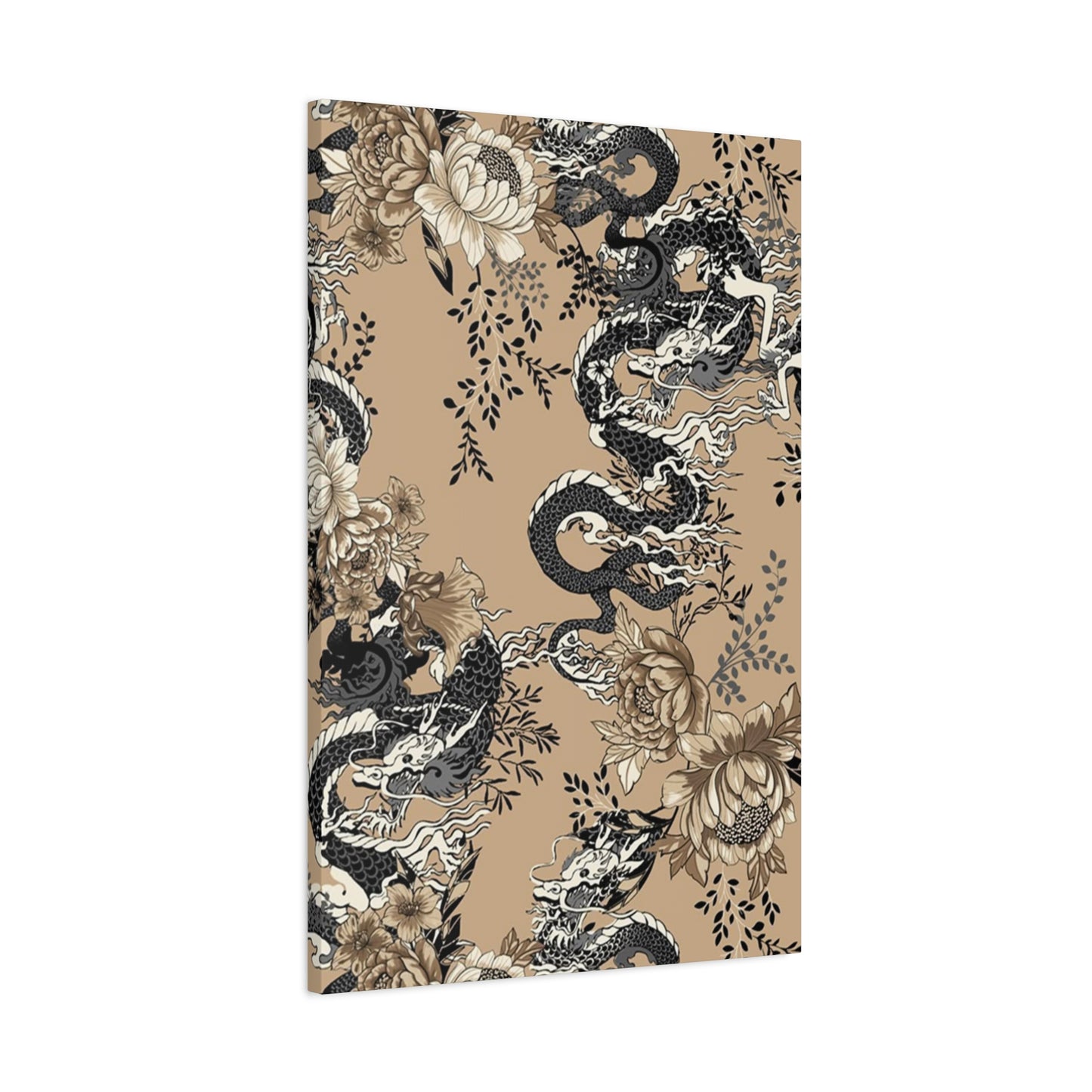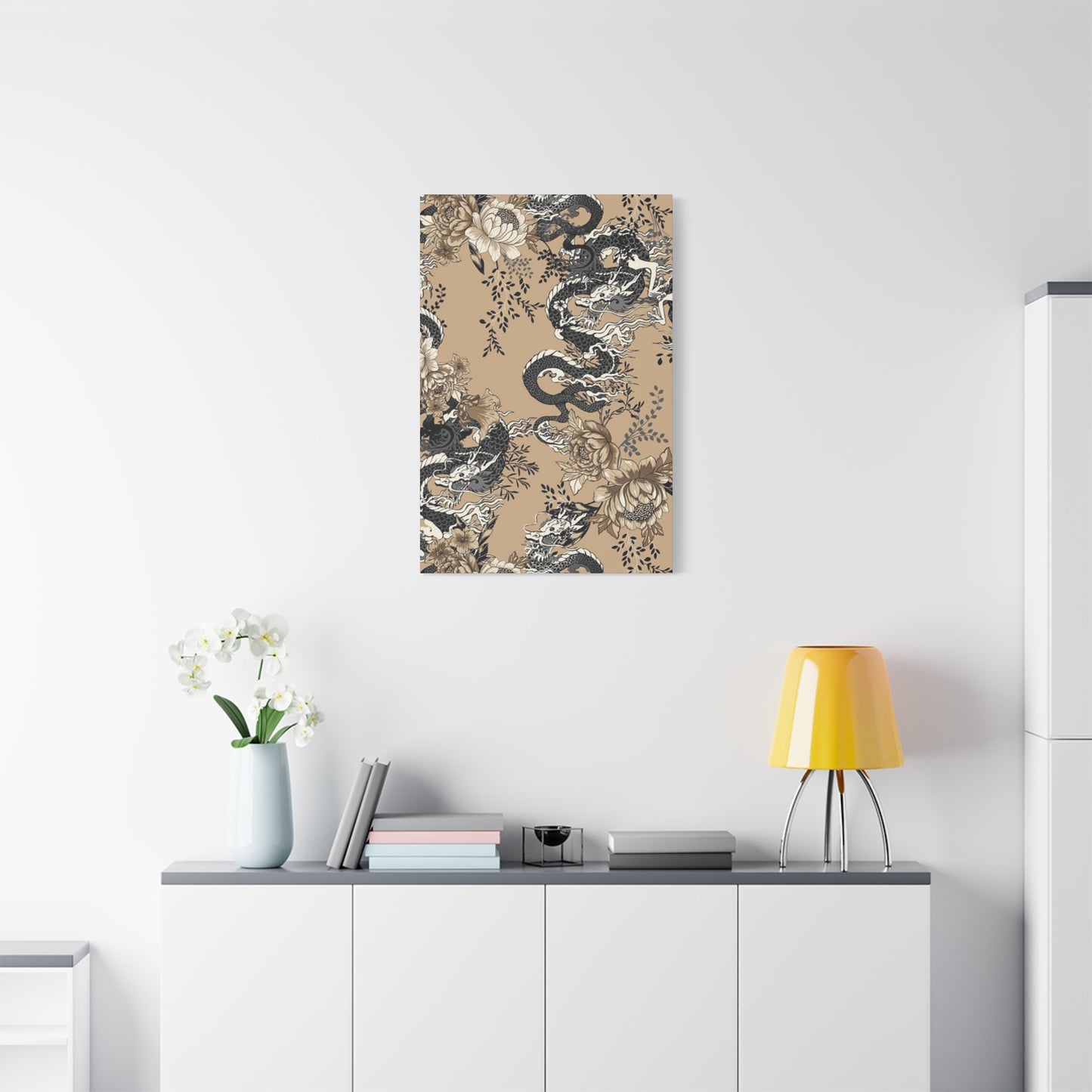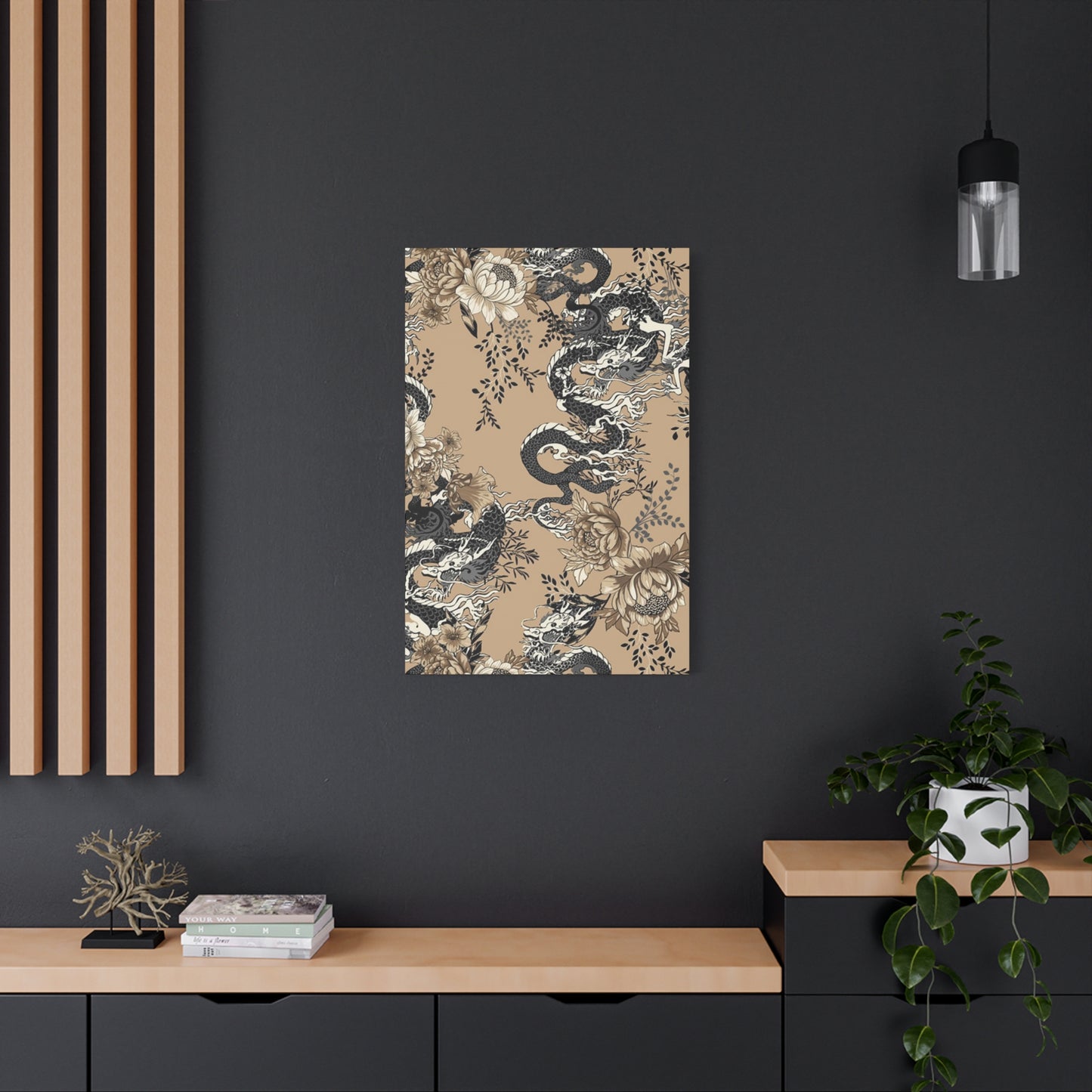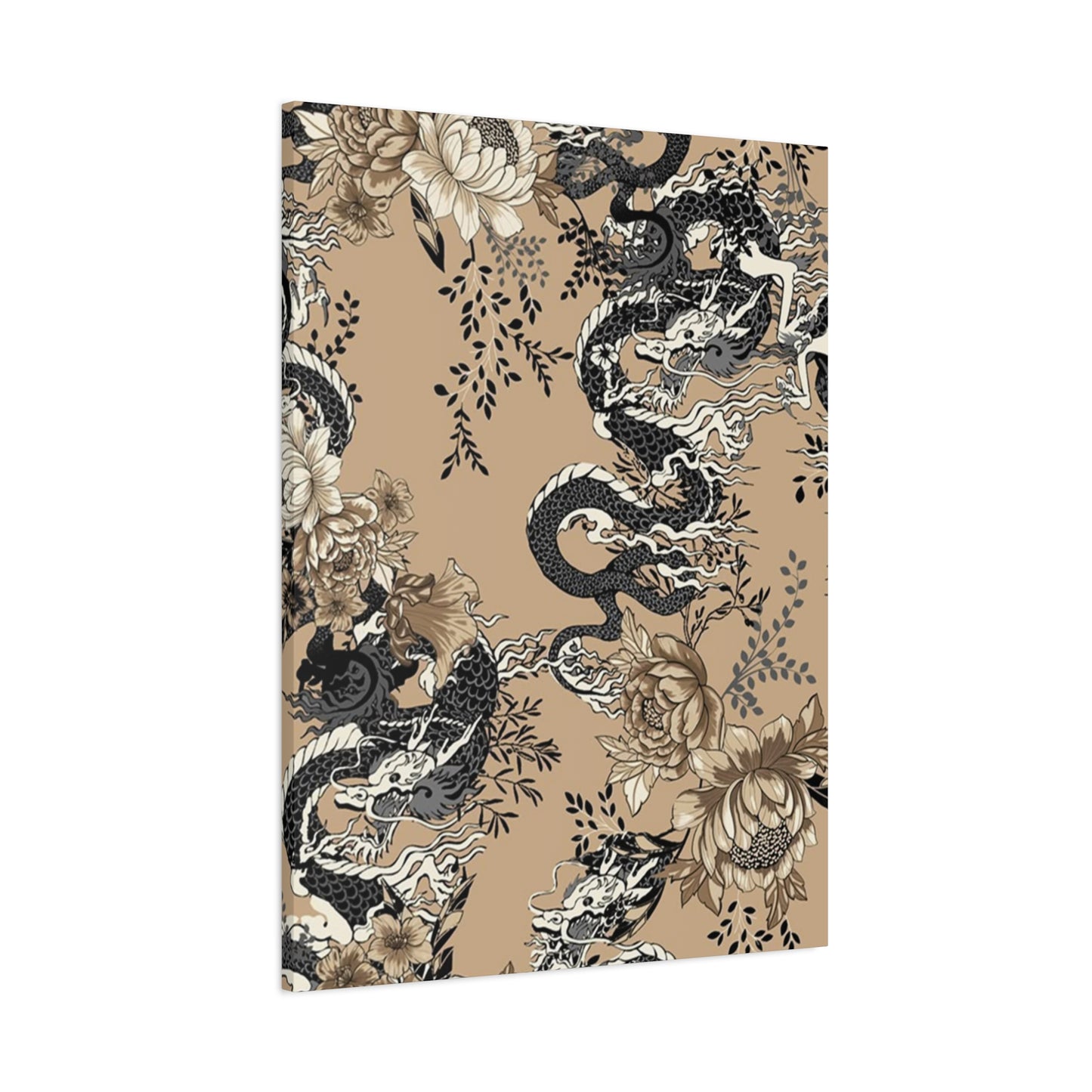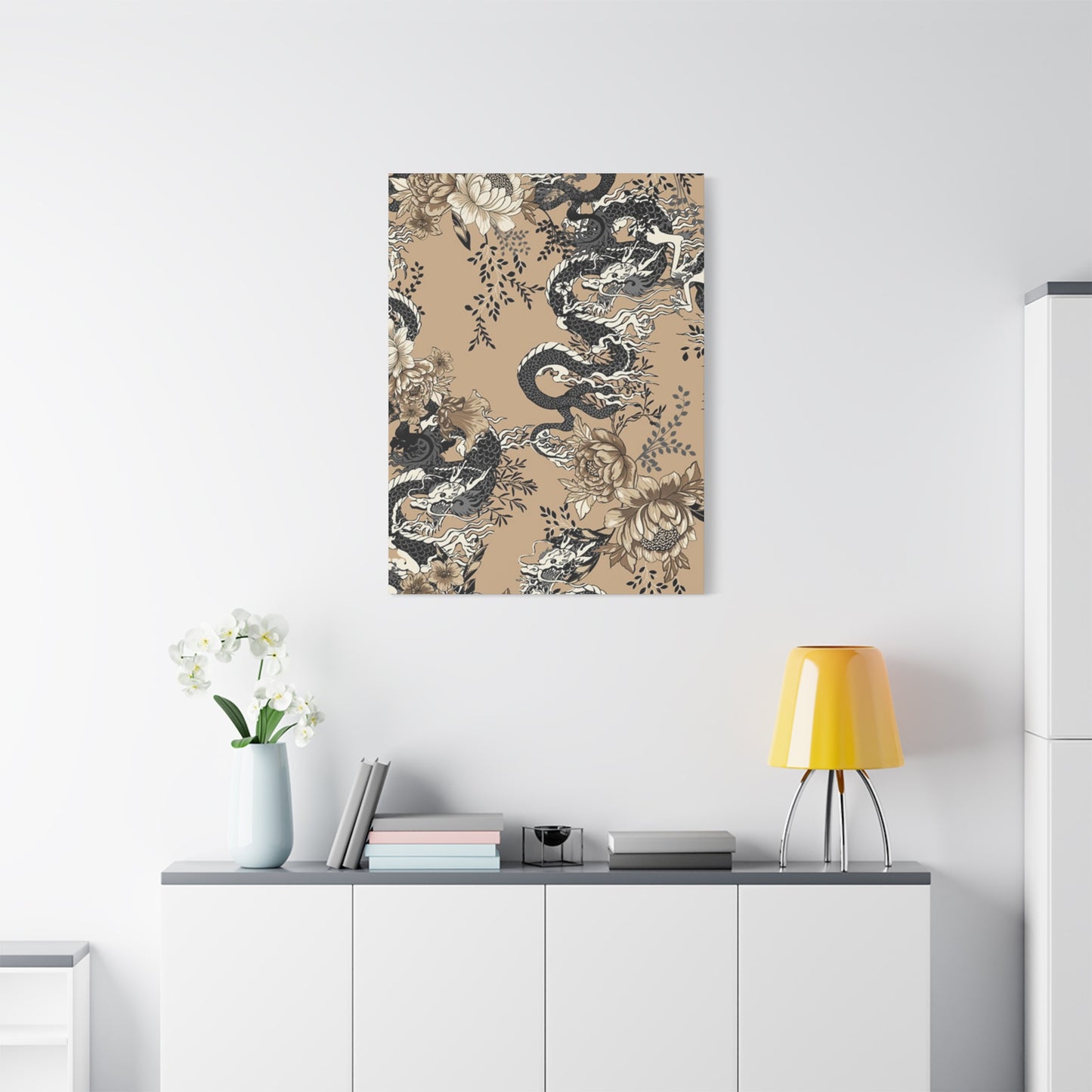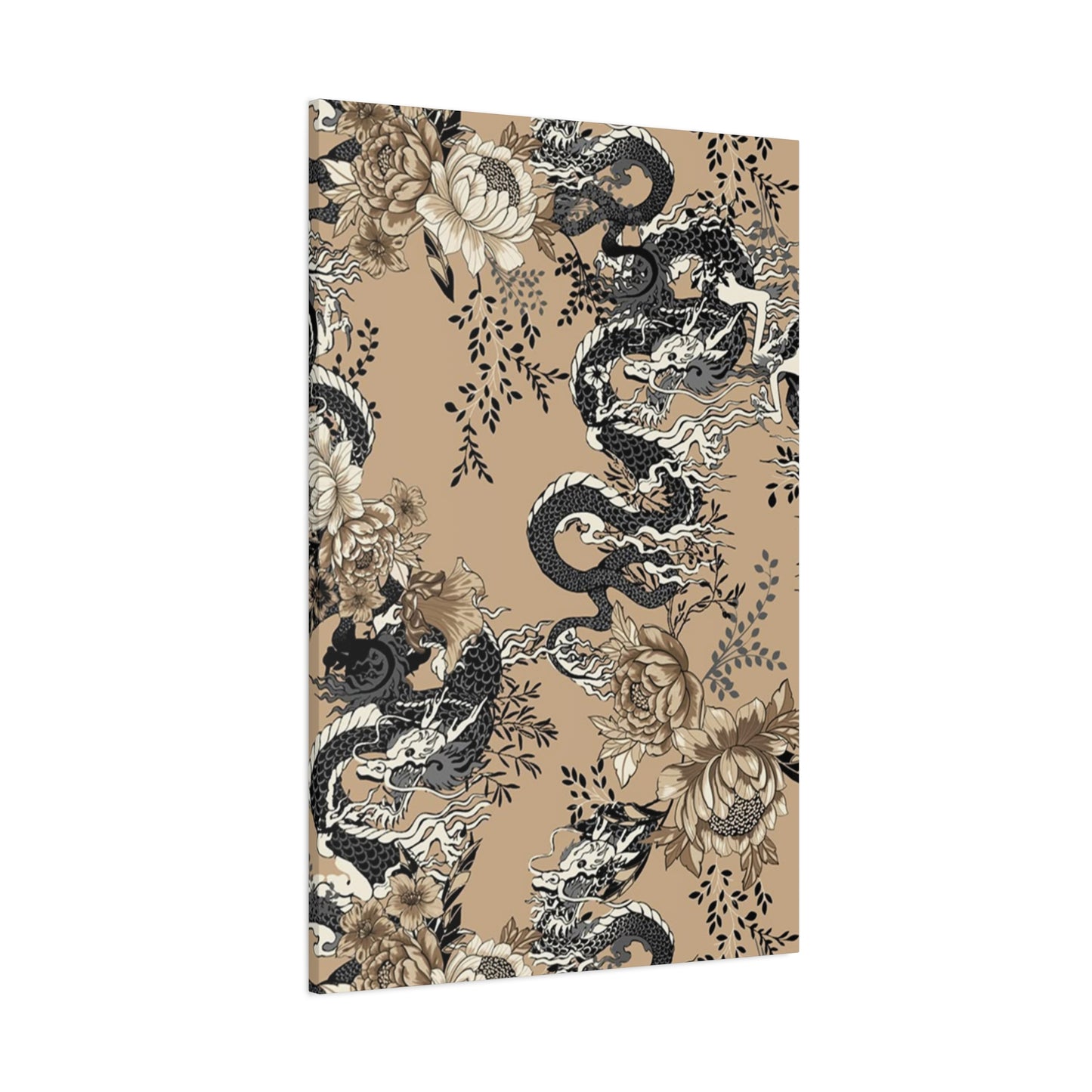Dragon And Snake Wall Art & Canvas Prints
Dragon And Snake Wall Art & Canvas Prints
Couldn't load pickup availability
Captivating Dragon And Snake Wall Art: Mystical Creatures Bringing Power and Wisdom to Your Living Spaces
The ancient symbolism of dragons and serpents has captivated human imagination across countless civilizations for millennia. These magnificent creatures represent duality, transformation, strength, and cosmic balance. When incorporated into decorative pieces for interior environments, dragon and snake wall art creates an atmosphere charged with mythological significance and visual dynamism. This comprehensive exploration delves into every facet of selecting, displaying, and appreciating these powerful symbolic representations in residential and commercial settings.
Ancient Symbolism Behind Serpentine Creatures in Various Cultural Contexts
Throughout human civilization, dragons and serpents have occupied prominent positions in mythological narratives, religious iconography, and philosophical teachings. Eastern traditions particularly revered dragons as benevolent celestial beings associated with water, weather phenomena, and imperial authority. Chinese cosmology depicts dragons as yang energy embodiments, representing masculine vitality, while serpents often symbolize feminine wisdom and earth connections.
In contrast, Western medieval traditions frequently portrayed dragons as formidable adversaries requiring heroic conquest, symbolizing chaos requiring order's imposition. Serpents carried similarly ambivalent meanings, from the Garden of Eden's tempter to Asclepius's healing rod-entwined snake representing medical knowledge. This rich tapestry of contradictory yet complementary meanings makes dragon and snake wall art particularly fascinating for contemporary collectors.
Japanese mythology introduced unique dragon variants like the mizuchi water deities and the tatsu celestial dragons that controlled rainfall and agricultural prosperity. Korean legends spoke of imugi, proto-dragons aspiring toward full draconic transformation after millennia of cultivation. Vietnamese folklore celebrated dragon-descended lineages among royal families, establishing divine right through reptilian ancestry claims.
Mesoamerican civilizations worshipped Quetzalcoatl, the magnificent feathered serpent deity representing wind, wisdom, and cultural enlightenment. This plumed dragon figure combined avian and reptilian characteristics, embodying dual nature philosophy central to Aztec and Mayan cosmological understanding. Such cross-cultural variations demonstrate humanity's universal fascination with these mythical beings.
Nordic mythology featured Jormungandr, the world serpent encircling Midgard's entirety, whose release would signal Ragnarok's apocalyptic events. Fafnir transformed from dwarf to dragon through cursed gold's corrupting influence, illustrating greed's transformative dangers. These Norse narratives emphasized dragons as primordial chaos forces requiring constant vigilance and heroic intervention.
Hindu traditions venerated nagas, serpentine beings dwelling in underwater kingdoms, controlling weather patterns and guarding treasures. These entities could assume human form and frequently interacted with deities and mortals alike. Buddhist iconography incorporated naga imagery extensively, with serpent kings protecting Buddha during meditation, demonstrating enlightenment's protective power over base instincts.
Aboriginal Australian dreamtime stories featured Rainbow Serpents as creation beings shaping landscapes, watercourses, and seasonal patterns. These primordial entities embodied life force itself, demonstrating how indigenous cultures recognized serpentine symbolism's fundamental connection to existence's cyclical nature. Such universal themes transcend geographical boundaries, revealing shared human psychological archetypes.
Diverse Artistic Styles Depicting These Legendary Beings
Dragon and snake wall art manifests through remarkably varied aesthetic approaches, each reflecting distinct cultural sensibilities and artistic movements. Traditional Chinese brush painting emphasizes fluid lines and minimalist composition, capturing draconic essence through suggestive strokes rather than detailed rendering. These pieces typically feature dragons amid swirling clouds or emerging from turbulent waters, executed in monochromatic ink on silk or rice paper.
Japanese ukiyo-e woodblock prints showcase serpentine creatures with extraordinary chromatic vibrancy and intricate pattern work. Artists like Hokusai and Kuniyoshi depicted dragons with meticulous scale textures, dynamic poses, and dramatic environmental contexts. These compositions balance negative space with densely detailed areas, creating visual tension that draws viewers into mythological narratives.
Contemporary realism brings photographic precision to fantastical subjects, rendering every scale, talon, and serpentine coil with hyperrealistic detail. Digital artists utilize sophisticated rendering software to create dragons with anatomically plausible musculature, believable lighting effects, and environmental interactions. These pieces blur boundaries between imagination and reality, making mythical creatures tangibly present.
Abstract interpretations distill draconic forms into geometric patterns, color fields, and symbolic representations. Modernist approaches might reduce serpents to sinuous lines flowing across canvas surfaces, evoking movement and energy without literal depiction. Such pieces allow viewers' imaginations to complete the representation, creating personal mythological encounters.
Gothic and dark fantasy aesthetics emphasize dragons' fearsome aspects through dramatic chiaroscuro lighting, volcanic environments, and menacing poses. These compositions often incorporate skeletal elements, shadowy atmospheres, and apocalyptic settings that emphasize these creatures' destructive potential. Such artwork appeals to those appreciating mythology's darker dimensions.
Celtic knotwork traditions incorporate serpentine forms into infinite interlacing patterns symbolizing eternity, interconnection, and cosmic unity. These designs transform dragons and snakes into decorative elements while maintaining their symbolic potency. The mathematical precision underlying Celtic patterns creates meditative visual experiences.
Art nouveau movements embraced organic, flowing lines perfectly suited to serpentine representation. Artists like Alphonse Mucha incorporated snake motifs into decorative panels featuring elegant curves, botanical elements, and feminine figures. These pieces demonstrate how reptilian forms harmonize with naturalistic ornamentation.
Street art and urban graffiti culture has adopted dragon imagery for large-scale murals combining spray paint techniques with stenciling, creating vibrant public artworks. These contemporary expressions often fuse Eastern dragon imagery with Western hip-hop aesthetics, producing culturally hybrid visual statements.
Tribal and indigenous artistic traditions reduce dragons and serpents to essential symbolic forms using limited color palettes and bold, graphic shapes. Polynesian, Maori, and Native American artistic conventions transform these creatures into totemic representations carrying specific clan or spiritual meanings.
Material Considerations for Long-Lasting Decorative Pieces
The substrate and medium selection significantly impacts dragon and snake wall art's durability, appearance, and suitability for various environmental conditions. Canvas remains the most popular choice for reproductions and original paintings, offering textured surfaces that enhance visual depth. Gallery-wrapped canvas extends around wooden frames, eliminating visible edges and creating contemporary clean aesthetics.
Metal prints utilize dye-sublimation processes to infuse images directly into aluminum surfaces, producing exceptionally vibrant colors with remarkable durability. These pieces resist moisture, fading, and physical damage while maintaining lightweight profiles. The metallic substrate adds luminous quality particularly effective for depicting dragons' supernatural radiance.
Acrylic glass mounting creates floating appearances with impressive depth and color saturation. High-resolution images printed on archival paper get sandwiched between acrylic layers, protecting artwork while enhancing visual impact through light refraction. These contemporary presentations suit modern interior designs emphasizing minimalist aesthetics.
Wood panel prints offer rustic charm while providing rigid, warp-resistant surfaces. Direct printing onto birch, maple, or bamboo panels creates organic presentations connecting mythological subjects with natural materials. Wood grain patterns sometimes intentionally show through, adding textural complexity to compositions.
Traditional framed prints behind glass protection remain timeless choices for dragon and snake wall art. Museum-quality matting, UV-protective glazing, and archival mounting techniques ensure longevity for valuable pieces. Frame selection dramatically affects overall presentation, from ornate gilded options to sleek contemporary profiles.
Tapestry and textile wall hangings provide tactile richness and acoustic benefits while displaying serpentine imagery. Woven or printed fabric pieces introduce softness contrasting with rigid wall surfaces. These options work particularly well in spaces prioritizing comfort and warmth over stark minimalism.
Carved wood reliefs add three-dimensional sculptural qualities to dragon representations. Skilled artisans create depth variations through carving techniques, allowing lighting to create dynamic shadow patterns. These pieces bridge painting and sculpture, offering tactile and visual appeal simultaneously.
Stone engravings and slate carvings connect dragon imagery with geological permanence. Laser etching or traditional chiseling techniques produce lasting images on marble, granite, or slate surfaces. These substantial pieces convey gravitas appropriate for dragons' mythological importance.
Ceramic tile murals allow for large-scale dragon installations suitable for outdoor environments, bathrooms, or kitchens. Fired glazes withstand moisture and temperature fluctuations while maintaining color integrity indefinitely. Modular tile systems enable custom sizing for specific architectural contexts.
Color Psychology and Its Impact on Atmosphere Creation
Chromatic choices in dragon and snake wall art profoundly influence emotional responses and spatial perceptions. Crimson and scarlet hues evoke passion, vitality, and primal energy associated with fire-breathing dragons. These warm tones create stimulating environments suitable for social spaces but potentially overwhelming in restful areas.
Azure and cobalt blues connect with water dragons and celestial serpents, promoting tranquility, contemplation, and mental clarity. Cool blue palettes lower perceived temperatures and create expansive spatial feelings. These colors work excellently in meditation spaces, offices requiring focus, or bedrooms prioritizing relaxation.
Emerald and jade greens reference nature, growth, and the life force serpents symbolize in many traditions. Green dragons particularly resonate with environmental consciousness and natural harmony. These balanced hues suit nearly any space, promoting renewal and vitality without excessive stimulation.
Golden and amber tones convey wealth, wisdom, and divine associations prevalent in Asian dragon mythology. Metallic gold accents catch light dynamically, adding luxury and visual interest. These warm metallics complement traditional and contemporary interiors while referencing dragons' treasure-hoarding legendary behaviors.
Obsidian blacks and charcoal grays emphasize dragons' mysterious, formidable aspects while providing sophisticated neutral foundations. Dark backgrounds make chromatic elements appear more luminous through contrast. These dramatic choices suit spaces embracing bold, masculine aesthetics.
Ivory and pearl whites create ethereal, spiritual representations of serpentine beings as enlightenment symbols. Light palettes expand spatial perceptions and reflect illumination, brightening environments. White dragons particularly resonate with purity, transcendence, and spiritual evolution themes.
Purple and violet shades combine red's energy with blue's tranquility, representing mysticism, transformation, and magical power. These regal colors historically associated with nobility complement dragon imagery's imperial connections. Amethyst tones work well in creative spaces or spiritual sanctuaries.
Multi-chromatic rainbow serpents reference indigenous Australian mythology while creating visually dynamic, celebratory atmospheres. Varied color transitions along serpentine bodies suggest movement and vitality. These vibrant pieces serve as conversation focal points and energetic room anchors.
Monochromatic schemes using single color variations create sophisticated, cohesive presentations. Sepia-toned dragons evoke antiquity and timelessness, while purely black-and-white compositions emphasize form over chromatic distraction. These restrained palettes suit minimalist or classically elegant interiors.
Placement Strategies for Maximum Visual Impact
Strategic positioning determines how effectively dragon and snake wall art transforms spaces. Focal walls in living rooms, behind seating arrangements or opposite entry points, provide ideal locations for large-scale pieces. These prominent positions ensure artwork receives appropriate attention while anchoring room design schemes.
Above furniture placement requires careful measurement ensuring adequate spacing between decorative pieces and functional elements below. Standard recommendations suggest leaving eight to twelve inches between sofa backs and lower artwork edges, preventing cramped appearances while maintaining visual connections.
Hallway galleries transform transitional spaces into artistic experiences through sequential dragon and snake wall art arrangements. Corridor displays allow for narrative progressions or thematic variations, guiding movement through residential or commercial environments. Consistent spacing and alignment create professional, curated aesthetics.
Stairway walls provide vertical display opportunities often underutilized in interior design. Ascending or descending arrangements can follow staircase angles, creating dynamic diagonal compositions. These challenging spaces benefit from serpentine subjects whose natural curves complement architectural lines.
Bedroom placement considerations balance visual interest with restful atmospheres. Positioning dragon and snake wall art across from beds rather than directly overhead prevents subconscious anxiety about suspended objects. Calmer chromatic choices and less aggressive dragon depictions suit sleeping environments better than dramatic, action-oriented pieces.
Office and workspace installations should inspire without distracting. Positioning artwork within peripheral vision rather than direct sightlines maintains focus on tasks while providing contemplative breaks. Dragons symbolizing wisdom, prosperity, and power particularly suit professional environments.
Dining area displays enhance social experiences through conversation-starting imagery. Dragon and snake wall art with cultural significance can prompt discussions about mythology, travel experiences, or artistic appreciation. These communal spaces accommodate bold, colorful pieces that might overwhelm more intimate settings.
Bathroom and powder room installations require moisture-resistant materials and mounting methods. Smaller dragon and snake wall art pieces work well in these compact spaces, adding personality without overwhelming limited square footage. Water-associated serpents and dragons thematically align with these functional spaces.
Commercial environments like restaurants, hotels, or retail establishments utilize dragon and snake wall art for branding and atmosphere creation. Large-scale installations make architectural statements while reinforcing cultural themes or establishment narratives. These public displays benefit from durable materials withstanding environmental conditions and public interaction.
Dimensional Variations from Miniature to Monumental Scales
Size selection dramatically affects dragon and snake wall art's presence and appropriateness for specific spaces. Miniature pieces measuring under twelve inches suit intimate viewing distances in personal spaces, desks, or small wall sections between architectural features. These delicate works reward close examination revealing intricate details invisible from distances.
Small-format pieces ranging from twelve to twenty-four inches work well in groupings creating gallery walls or as accent pieces complementing larger artworks. These flexible sizes accommodate varied spatial constraints while maintaining visual impact through strategic arrangements.
Medium-sized dragon and snake wall art spanning twenty-four to forty-eight inches provides substantial presence without overwhelming average residential rooms. These dimensions work universally across living rooms, bedrooms, and offices, offering balanced focal points neither dominating nor disappearing within spaces.
Large-scale pieces exceeding forty-eight inches make bold architectural statements requiring careful spatial planning. These commanding artworks suit spacious interiors with high ceilings and open floor plans. Single oversized dragon depictions often prove more effective than multiple smaller pieces in grand spaces.
Panoramic formats stretching horizontally emphasize serpentine creatures' elongated bodies naturally. Wide, relatively shallow compositions work particularly well above furniture or in spaces with horizontal emphasis. Multi-panel triptychs or polyptychs extend panoramic effects while allowing flexible arrangement configurations.
Vertical orientations suit narrow wall sections, alongside doorways, or in spaces with pronounced height. Rising dragon compositions soaring upward through clouds or emerging from depths particularly benefit from vertical formats emphasizing ascension and power.
Sculptural three-dimensional dragon and snake wall art extends beyond flat surfaces, creating shadow plays and viewing angle variations. Relief depths ranging from subtle to dramatically pronounced add architectural interest while maintaining wall-mounted convenience. These pieces bridge decorative arts and sculptural traditions.
Custom-sized commissions accommodate specific architectural requirements or design visions. Working directly with artists or specialized producers ensures perfect dimensional fits for unusual spaces, curved walls, or integrated design schemes requiring precise specifications.
Modular systems allow progressive additions or reconfigurations as spaces evolve. Sectional dragon and snake wall art pieces fit together creating larger compositions or function independently, providing flexibility for renters or those anticipating relocation.
Lighting Considerations Enhancing Serpentine Artistry
Illumination profoundly affects how dragon and snake wall art appears and impacts surrounding environments. Natural daylight creates dynamic viewing experiences as sunlight angles shift throughout days and seasons. Positioning artwork perpendicular to windows prevents glare while allowing ambient illumination to reveal colors and details naturally.
Picture lights mounted directly above or below artworks provide focused illumination highlighting specific pieces. LED fixtures offering adjustable color temperatures allow customization from warm, intimate glows to cool, gallery-style lighting. These dedicated light sources ensure artwork remains visible regardless of ambient conditions.
Track lighting systems enable adjustable spotlighting directing attention toward dragon and snake wall art while maintaining flexibility for rearrangements. Multiple adjustable fixtures along ceiling-mounted tracks accommodate evolving display configurations and varying illumination needs throughout spaces.
Recessed ceiling fixtures with directional trim provide subtle, architectural lighting integration. Strategically positioned recesses cast light downward onto artwork without visible hardware cluttering wall surfaces. These professional installations suit contemporary, minimalist aesthetics.
Wall-washing techniques illuminate entire vertical surfaces evenly, creating gallery-like presentations. This approach suits spaces displaying multiple artworks or where dragon and snake wall art shares walls with other decorative elements. Uniform illumination prevents hotspots and shadows that might distract from compositions.
Accent lighting from table or floor lamps positioned near artwork provides supplementary illumination during evening hours. Indirect bounced light creates softer, more atmospheric effects than direct spotlighting. Layered lighting schemes combining multiple sources offer greatest control over ambiance and visibility.
Backlit mounting systems create dramatic halo effects around dragon and snake wall art, separating pieces visually from wall surfaces. LED strips concealed behind artworks provide contemporary presentations particularly effective with translucent or semi-transparent materials like acrylic glass.
Color-changing smart lighting systems allow mood customization coordinating illumination with dragon imagery. Programmable LED fixtures might emphasize fiery reds for dragon pieces or cool blues for water serpents, creating immersive thematic experiences. These responsive systems appeal to those embracing smart home concepts.
Fireplace proximity provides organic, flickering illumination particularly appropriate for dragon imagery symbolically connected with flames. However, heat and smoke considerations require adequate spacing and protective measures preventing damage to valuable artworks.
Feng Shui Principles Guiding Dragon Placement
Traditional Chinese geomancy offers specific guidelines for positioning dragon imagery within residential and commercial spaces. Dragons represent powerful yang energy requiring careful placement avoiding inadvertent negative consequences. Understanding these principles helps create harmonious environments supporting occupants' wellbeing and prosperity.
Ideal dragon placement positions these celestial beings on left sides of main entrances when viewed from inside looking outward. This alignment corresponds with green dragon directional associations and protective energies safeguarding households. Right-side placement potentially creates imbalances favoring white tiger energies excessively.
Water element associations make dragon and snake wall art particularly appropriate for northern sectors corresponding with career and life path energies. These placements support professional advancement and personal growth. However, southern fire sectors might create elemental conflicts requiring careful consideration.
Living room dragon displays should position creatures facing inward toward room centers rather than toward exits or windows. Outward-facing dragons symbolically direct beneficial energies away from spaces rather than accumulating positive chi within environments. This orientation principle applies universally across various dragon artistic representations.
Bedroom dragon placement requires particular sensitivity given spaces' intimate, restful purposes. Overly aggressive or large dragon imagery might disturb sleep quality through excessive yang energy. Smaller, gentler serpentine representations better suit sleeping quarters, positioned where visible but not dominating consciousness.
Kitchen placements connect dragons with nourishment and abundance but risk symbolic water-fire element conflicts with cooking spaces. Balancing considerations include selecting earth-tone dragon imagery or wood element frames mediating between opposing forces according to productive cycle relationships.
Home office dragon and snake wall art supports authority, wisdom, and career success when positioned behind desk seating. This placement literally and symbolically backs occupants with draconic power during professional activities. Facing dragons might create confrontational energies less conducive to focused work.
Pairing dragon imagery with complementary symbols like phoenixes creates balanced masculine-feminine energy dynamics. Dragon-phoenix combinations represent ideal partnerships and marital harmony, making such pieces appropriate for shared spaces or master bedrooms supporting relationship goals.
Avoiding dragon placement in bathrooms prevents symbolically flushing away beneficial energies these creatures represent. Similarly, positioning dragons where directly viewed from toilets creates inauspicious spatial relationships according to traditional interpretations. Respecting these taboos ensures harmonious environmental energy flows.
Multiple dragon depictions require careful number considerations. Odd numbers generally prove more auspicious than even quantities, with nine holding particularly powerful significance as representing completeness and celestial authority. Pairing considerations and grouping arrangements should reflect these numerological principles.
Pairing Serpentine Imagery with Complementary Decorative Elements
Dragon and snake wall art achieves maximum impact through thoughtful coordination with surrounding furnishings, textiles, and decorative accessories. Asian-inspired decor naturally complements Eastern dragon imagery through cohesive cultural aesthetics. Elements like bamboo furniture, silk cushions, and ceramic vases create harmonious environments respecting artistic traditions.
Contemporary minimalist spaces benefit from dragon and snake wall art as bold focal points contrasting with otherwise restrained environments. Clean lines, neutral palettes, and uncluttered surfaces allow serpentine imagery to dominate attention without competing visual elements. This juxtaposition creates dynamic tension between ancient symbolism and modern design.
Gothic or dark romantic interiors embrace dragons' mysterious, powerful aspects through coordinated color schemes emphasizing deep purples, blacks, and crimsons. Velvet textiles, wrought iron fixtures, and dramatic drapery enhance mythological atmospheres. These environments immerse occupants in fantastical realms where dragons seem naturally present.
Natural organic interiors featuring wood tones, stone textures, and botanical elements contextualize serpentine creatures within environmental settings. This approach emphasizes dragons' connections to natural forces and elemental powers. Live plants, water features, and earth-toned palettes create grounded, balanced spaces.
Metallic accents in gold, silver, or bronze complement dragon and snake wall art while referencing these creatures' legendary treasure associations. Decorative objects, light fixtures, and furniture details incorporating metallic finishes create cohesive visual themes. Warm metals suit fire dragons while cool silvers complement water serpents.
Textile selections including throw pillows, area rugs, and window treatments should either complement artwork colors or provide neutral foundations preventing visual chaos. Repeating specific hues from dragon and snake wall art throughout spaces creates intentional color stories unifying design schemes.
Sculptural objects and three-dimensional accessories add dimensional variety to spaces dominated by two-dimensional wall art. Ceramic dragon figurines, carved wooden serpents, or bronze statues extend mythological themes throughout environments. These supporting elements create immersive experiences rather than isolated artistic statements.
Mirror placement near dragon and snake wall art can amplify presence through reflections while symbolically doubling beneficial energies according to certain belief systems. However, mirrors directly facing dragon imagery might create energy deflection concerns in Feng Shui practice, requiring thoughtful positioning.
Bookshelf styling with mythology references, fantasy literature, and cultural histories reinforces intellectual engagement with dragon themes beyond purely decorative appreciation. Curated collections demonstrate genuine interest in subjects rather than superficial trend-following, adding depth to interior narratives.
Curatorial Approaches for Gallery Wall Compositions
Multiple dragon and snake wall art pieces arranged together create narrative experiences greater than individual component sums. Thematic gallery walls might explore dragons across different cultural traditions, showcasing Chinese, Japanese, European, and Mesoamerican interpretations side-by-side. These comparative displays educate viewers while creating visually rich tapestries.
Chronological arrangements trace artistic evolution from ancient manuscript illuminations through contemporary digital renderings. These historical progressions demonstrate changing aesthetic sensibilities while maintaining thematic consistency. Educational labels or subtle dating elements enhance intellectual engagement.
Color gradient organizations transition serpentine imagery from cool to warm tones across wall surfaces. This rainbow progression creates satisfying visual rhythms while maintaining subject consistency. Gradient approaches work particularly well with abstract or stylized dragon representations emphasizing chromatic qualities over detailed rendering.
Size variation rhythms alternate large focal pieces with smaller supporting artworks preventing monotonous uniformity. This dynamic scaling creates visual interest guiding eye movement across compositions. Central anchor pieces flanked by progressively smaller satellites exemplify effective sizing strategies.
Frame consistency versus eclectic variety represents key curatorial decisions affecting overall impressions. Uniform framing creates cohesive, gallery-like presentations suggesting careful curation. Varied frames add personal, collected-over-time aesthetics appearing less calculated and more organically assembled.
Symmetrical versus asymmetrical arrangements reflect different design philosophies. Formal symmetry conveys order, balance, and classical aesthetics. Asymmetrical salon-style hangings appear more casual, creative, and contemporary. Neither approach inherently superior; appropriateness depends on surrounding interior contexts and personal preferences.
Geometric patterns like grids provide structured frameworks for gallery walls featuring dragon and snake wall art. Consistent spacing and alignment create professional appearances suitable for modern interiors. These organized systems accommodate varying artwork sizes through calculated positioning.
Organic, flowing arrangements echo serpentine forms themselves, creating meta-compositions where individual pieces collectively suggest larger dragon shapes. This sophisticated approach requires careful planning but produces remarkable results rewarding sustained viewing.
Negative space considerations prevent overcrowding while allowing individual artworks breathing room. Adequate spacing between pieces enables focused appreciation of each dragon and snake wall art element without overwhelming visual competition. Balance between coverage and emptiness remains crucial for successful gallery walls.
Mythological Narratives Depicted Through Visual Storytelling
Dragon and snake wall art frequently illustrates specific legendary tales embedded with cultural meanings. Chinese mythology's Dragon Gate legend depicts carps transforming into dragons after successfully leaping waterfalls, symbolizing perseverance rewarded with transcendence. Artworks capturing this narrative inspire determination and personal growth aspirations.
Saint George's dragon-slaying episode represents Christianity's triumph over paganism and good vanquishing evil. Medieval artistic interpretations show armored knights confronting fearsome beasts, emphasizing heroic virtues and moral clarity. These dramatic confrontations create dynamic compositions filled with tension and movement.
Japanese tales of dragon princesses dwelling in underwater palaces inspire romantic, fantastical imagery. These benevolent beings reward virtuous humans with treasures and wisdom, contrasting Western dragons' typically adversarial relationships with humanity. Such narratives enable gentler, more whimsical artistic interpretations.
Norse mythology's Sigurd and Fafnir story explores greed's corrupting influence through dwarf-turned-dragon narratives. Depictions emphasize transformation themes and moral consequences while providing opportunities for dramatic treasure hoard settings. These complex narratives support sophisticated artistic explorations.
Hindu naga kings protecting Buddha during meditation appear frequently in Buddhist iconography. Multi-headed serpent deities shelter meditating figures beneath cobra hoods, symbolizing enlightenment's protective power. These serene compositions promote spiritual contemplation and peaceful energies.
Quetzalcoatl imagery combines serpent bodies with brilliant plumage creating visually spectacular compositions. Mesoamerican artistic styles emphasize geometric patterns, bold colors, and symbolic complexity. These culturally distinct representations offer alternatives to more familiar Asian or European dragon traditions.
Aboriginal Rainbow Serpent creation narratives show landscape-shaping primordial beings. These meandering, polychromatic creatures literally form rivers, mountains, and valleys through their movements. Such imagery connects mythology with geographical features, grounding fantastic narratives in physical reality.
Ouroboros symbolism depicting serpents consuming their own tails represents eternal cycles, self-reflection, and cosmic unity. These circular compositions lack clear beginnings or endings, creating meditative focal points. Ancient Greek, Egyptian, and Norse traditions all featured ouroboros imagery, demonstrating widespread philosophical resonance.
Hydra's multiple regenerating heads from Greek mythology inspire complex, multi-focal compositions. These many-headed serpentine creatures symbolize problems multiplying when improperly addressed. Artistic interpretations emphasize multiplication, complexity, and challenging adversaries requiring clever solutions.
Commissioning Custom Pieces Reflecting Personal Vision
Bespoke dragon and snake wall art allows precise realization of individual aesthetic preferences, spatial requirements, and symbolic intentions. Working directly with artists begins with articulating desired moods, cultural references, and compositional elements. Clear communication ensures final pieces align with expectations while respecting artistic interpretation.
Selecting appropriate artists requires researching portfolios, reviewing previous commissions, and evaluating stylistic compatibilities. Some creators specialize in traditional painting methods while others focus on digital rendering, mixed media, or sculptural approaches. Matching artistic strengths with project requirements ensures satisfactory outcomes.
Dimensional specifications for custom dragon and snake wall art must account for specific installation locations, viewing distances, and surrounding architectural features. Providing artists with photographs, measurements, and contextual information enables appropriate scaling decisions. Oversized pieces require additional structural considerations during creation and mounting.
Color consultations establish palettes harmonizing with existing interior schemes or introducing intentional contrasts. Bringing paint samples, fabric swatches, or photographs of spaces helps artists understand chromatic contexts. Some creators provide digital mockups showing how finished pieces might appear in situ before beginning actual production.
Symbolic element inclusions personalize dragon and snake wall art beyond generic representations. Incorporating specific flowers, landscape features, or accompanying creatures adds layers of personal meaning. Discussing symbolism preferences ensures artists understand intended messaging and can suggest culturally appropriate combinations.
Timeline expectations require realistic assessment of creative processes, particularly for complex original artworks. Rushed commissions seldom produce optimal results; allowing adequate time for conception, execution, revisions, and proper curing or finishing ensures quality. Preliminary sketches or proofs enable course corrections before substantial investment occurs.
Pricing structures for commissioned dragon and snake wall art vary based on artist reputation, piece complexity, materials, and dimensions. Original paintings command higher prices than prints or reproductions. Transparent discussions about budgets, payment schedules, and deliverable expectations prevent misunderstandings disrupting creative collaborations.
Contracts formalizing commission agreements protect both patrons and artists. Written documents should specify dimensions, materials, deadlines, payment terms, revision allowances, and ownership rights. Clear agreements prevent disputes enabling positive creative partnerships.
Installation considerations for custom pieces might require professional hanging services, especially for heavy or unusually shaped artworks. Discussing mounting methods during commission processes ensures artists incorporate appropriate hardware and structural reinforcements. Some creators offer installation services or recommendations for qualified professionals.
Preservation Practices Ensuring Longevity
Proper care extends dragon and snake wall art's lifespan while maintaining aesthetic qualities. Direct sunlight exposure causes pigment fading and material degradation over time. Positioning artwork away from windows or utilizing UV-filtering window treatments protects against solar damage. Rotating displayed pieces periodically distributes light exposure across collections.
Temperature and humidity fluctuations threaten artwork integrity through expansion, contraction, and moisture-related deterioration. Maintaining stable environmental conditions between 65-75 degrees Fahrenheit and 40-50% relative humidity prevents warping, cracking, or mold growth. Climate control systems benefit art collections significantly.
Dust accumulation dulls surfaces and can scratch delicate finishes during removal attempts. Regular gentle cleaning using soft, dry microfiber cloths prevents buildup. Avoiding feather dusters that might snag on textured surfaces or chemical cleaners potentially damaging protective coatings maintains artwork condition safely.
Framed pieces behind glass require careful cleaning avoiding ammonia-based products potentially damaging frames or mats. Distilled water with minimal gentle soap applied to soft cloths cleans glass effectively without leaving residues. Avoiding direct spray application prevents moisture infiltrating frames potentially damaging artwork.
Canvas paintings benefit from occasional professional conservation assessments checking for structural issues, pigment stability, or varnish deterioration. Qualified conservators can clean, repair, and restore artworks when necessary. Preventive conservation proves more cost-effective than addressing severe damage after occurrence.
Metal prints resist many traditional art preservation challenges but still require dust removal and fingerprint cleaning. Non-abrasive cloths with mild solutions maintain metallic surfaces' brilliance. Avoiding harsh chemicals prevents protective coating damage.
Wooden panels require monitoring for pest infestations, particularly in humid climates. Regular inspections detect early signs of wood-boring insects enabling prompt treatment. Maintaining proper environmental conditions discourages pest activity naturally.
Textile wall hangings and tapestries benefit from periodic vacuuming using low suction and protective mesh screens preventing fiber damage. Professional textile conservation for valuable pieces ensures proper cleaning methods preserving material integrity. Rotating displayed textiles prevents localized fading and wear patterns.
Documentation through photographs establishes condition records useful for insurance purposes and tracking any changes over time. Regular photographic updates create archives demonstrating proper stewardship should claims or authenticity verifications become necessary.
Authentication and Valuation for Collectors
Serious dragon and snake wall art collectors require understanding authentication processes and valuation factors. Provenance documentation tracing ownership histories establishes legitimacy and can significantly affect values. Continuous chains of custody from artists through subsequent owners provide strongest authentication evidence.
Artist signatures, edition numbers, and certificates of authenticity provide essential documentation for original works and limited editions. Verifying these markings against known exemplars prevents purchasing forgeries. Reputable galleries and dealers maintain authentication records for pieces they handle.
Condition significantly impacts collectible artwork values. Pristine examples command premiums over damaged or restored pieces. Professional condition reports document any issues affecting valuation. Conservation treatments, while preserving artworks, sometimes reduce values compared to unrestored originals if alterations are significant.
Rarity through limited edition sizes increases per-piece values. Low edition numbers (1/25) from small total runs prove more valuable than high numbers from large editions (250/500). Artist proofs and printer's proofs outside regular editions carry particular cachet among collectors.
Market demand for specific artists, styles, or subjects fluctuates affecting values. Dragon and snake wall art by renowned artists or from recognized schools commands higher prices than anonymous or amateur works. Researching comparable sales through auction databases and gallery records establishes realistic value expectations.
Exhibition histories enhance provenance and prestige. Artworks displayed in museum shows or significant galleries gain credibility and value appreciation. Documentation of exhibition participation through catalogs and labels strengthens authentication and market positioning.
Cultural significance and historical importance of dragon and snake wall art adds scholarly and collectible value beyond purely aesthetic considerations. Pieces documenting specific artistic movements, cultural moments, or significant artists' development stages interest institutions and serious collectors.
Professional appraisals establish formal valuations for insurance, estate planning, or sale purposes. Qualified appraisers examine physical characteristics, research provenance and market conditions, then provide documented value assessments. Different appraisal types serve specific purposes requiring appropriate professional credentials.
Insurance coverage protects valuable dragon and snake wall art collections against loss, damage, or theft. Specialized fine art insurance policies often provide better protection than standard homeowners policies. Regular appraisal updates ensure coverage amounts reflect current market values.
Regional Variations in Dragon Representation Styles
Geographic origins profoundly influence how dragon and snake wall art visualizes these mythological beings. Chinese dragons exhibit elongated, serpentine bodies with four relatively small legs, flowing whiskers, and benevolent expressions. These celestial creatures emphasize elegance and fluidity rather than fearsome power, often depicted amid clouds or waves.
Japanese dragons maintain serpentine characteristics but typically feature three toes per foot compared to Chinese counterparts' traditional five. Regional variations include more pronounced facial expressions, often fiercer or more dynamic poses. Japanese artistic styles emphasize decorative patterns and bold outlines characteristic of ukiyo-e traditions.
Korean dragons blend Chinese influences with distinctive local characteristics including longer beards and more prominent scales. These creatures often associate with water and agriculture, depicted protecting crops or controlling rainfall. Korean artistic interpretations incorporate bold colors and dynamic compositions reflecting peninsula culture's unique aesthetics.
European dragons dramatically contrast Asian interpretations through emphasis on wings, stockier bodies, and reptilian features resembling large lizards. Medieval illustrations portrayed these creatures as embodiments of evil requiring heroic conquest. Western dragon and snake wall art often depicts dramatic confrontations, treasure hoarding, or castle sieges.
Mesoamerican feathered serpents combine avian and reptilian characteristics unique to American indigenous traditions. Brilliant plumage, serpentine bodies, and symbolic complexity distinguish Quetzalcoatl representations from Old World dragons. Geometric patterns and vibrant colors reflect pre-Columbian artistic conventions.
Celtic dragons incorporated into knotwork designs emphasize decorative and symbolic functions over realistic rendering. These stylized creatures interweave with intricate patterns representing interconnection and eternity. Insular manuscript traditions produced particularly refined examples combining Christian and pagan imagery.
Middle Eastern and Persian dragons combine elements from various traditions through cultural crossroads positions. These creatures appear in miniature paintings with distinctive artistic styles emphasizing detailed patterns, vibrant colors, and fantastical landscapes. Islamic artistic prohibitions against figural representation sometimes led to highly stylized or abstract serpentine forms.
Southeast Asian dragons and nagas reflect Hindu and Buddhist influences combined with local traditions. Multi-headed serpent kings and water-dwelling dragons feature prominently in Thai, Cambodian, and Indonesian artistic traditions. These creatures guard temples and sacred sites, appearing in architectural ornamentation and religious artworks.
African dragon-like creatures appear in various regional mythologies though less commonly than in Eurasian traditions. When depicted, these beings often emphasize specific cultural values and local environmental features.
Conclusion
In conclusion, captivating dragon and snake wall art is an exceptional way to infuse your living space with symbolism, mysticism, and strength. These mythical creatures—dragons, often seen as powerful, wise beings, and snakes, revered for their transformative and healing properties—carry rich cultural and spiritual significance across various traditions. When brought into the realm of interior design, these creatures transcend mere decoration and become powerful visual statements, each telling its own story of power, wisdom, and ancient lore.
One of the most striking features of dragon and snake wall art is the deep symbolism they carry. Dragons are often associated with strength, protection, and ancient knowledge in cultures ranging from Eastern to Western traditions. In Chinese culture, for example, dragons are seen as guardians of wisdom and prosperity, while in European mythology, they represent a fierce and untamable force of nature. Similarly, snakes have been revered across civilizations as symbols of transformation, rebirth, and healing. Their ability to shed their skin represents renewal and change, while in many spiritual traditions, they are seen as symbols of enlightenment and balance.
When these mystical creatures are depicted in wall art, they become more than just stunning visuals; they serve as reminders of the values and lessons they embody. A dragon can inspire strength, courage, and leadership, while a snake can encourage introspection, personal growth, and the embracing of change. These symbolic elements can add a layer of meaning to your space, creating an environment that fosters empowerment, transformation, and personal reflection. Whether displayed in a bedroom, living room, or home office, dragon and snake wall art serves as a visual catalyst for personal and spiritual growth.
In terms of interior design, dragon and snake wall art are incredibly versatile. Whether you prefer a bold, modern take on these creatures or a more traditional, intricate depiction, these artworks can easily blend into various home styles. For a contemporary aesthetic, minimalist dragon illustrations or abstract snake designs can add a sleek, powerful edge to a modern living room or office. On the other hand, more detailed, traditional representations—such as a dragon coiling around a tree or a snake wrapped around an ancient staff—bring a sense of timelessness, making them perfect for classical, bohemian, or vintage-inspired interiors. The diversity in style allows these works to be adapted to suit any personal taste, making them a dynamic addition to your home.
Another notable aspect of dragon and snake wall art is the visual drama they create. The fluidity of a snake’s coils or the majestic form of a dragon’s wings can bring an element of movement and energy to a space. These designs often come with rich textures, vibrant colors, and intricate patterns, turning a simple wall into an energetic focal point. Depending on the medium used—whether painting, print, or sculpture—these artworks can imbue a room with dynamic energy, capturing the viewer’s attention while adding depth and intrigue to the space. Their dramatic and often larger-than-life presence can create a sense of grandeur and power, transforming an otherwise plain wall into a captivating piece of art.
The combination of mythical creatures and their rich symbolic meaning also offers an opportunity to connect with ancient traditions and philosophies. Many cultures have used dragons and snakes in their spiritual practices, seeing them as symbols of the forces of nature and human transformation. By integrating this kind of art into your home, you’re not only enhancing the aesthetic appeal of your living space but also inviting ancient wisdom and spiritual energy into your environment. This creates a space where you can reflect on your own journey, connect with your inner power, and embrace the mysteries of life.
Moreover, captivating dragon and snake wall art can spark conversations and offer a sense of mystique. These creatures, with their complex symbolism and mythical backgrounds, often intrigue and fascinate those who encounter them. A well-placed piece of wall art can serve as an icebreaker in social settings, allowing for discussions about the various cultural meanings behind dragons and snakes or the personal significance they hold for you. It’s a way to share your values, beliefs, and aesthetic preferences with guests, creating a space that feels both personal and inviting.
In the end, dragon and snake wall art are more than just decorative elements—they are potent symbols that bring strength, wisdom, and transformation into your home. Whether you choose an intricate, traditional design or a minimalist, modern interpretation, these mythical creatures can enrich your living spaces by adding layers of meaning, energy, and spiritual depth. With their timeless appeal and profound symbolism, they offer a way to transform your home into a space that is not only beautiful but also meaningful, empowering you to embrace your inner strength and embark on a journey of personal growth and self-discovery.
Share
